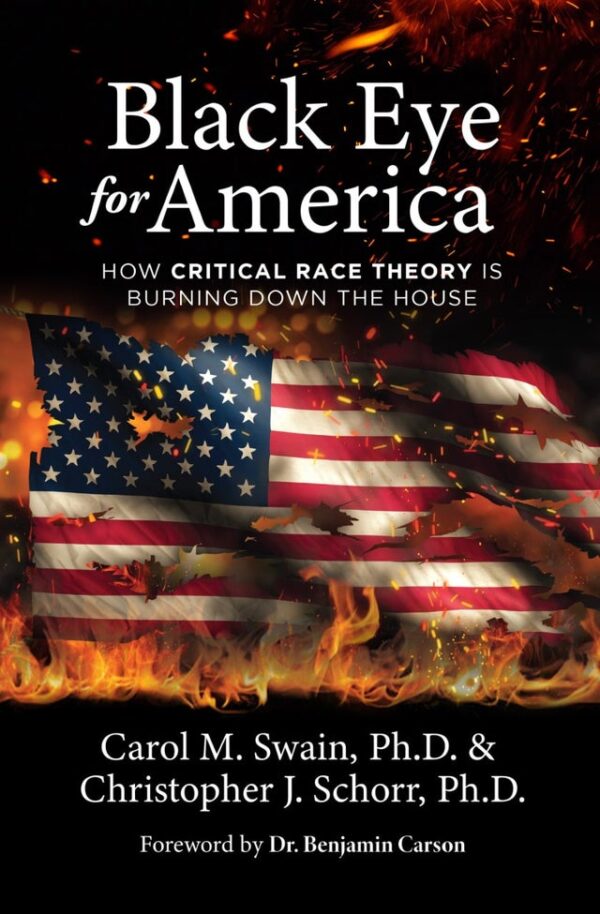The following article was copied and pasted from my Epoch Times electronic subscription to display their reporting and concern for truth and facts; and to provide a perspective not possible via big media and social media, as they only publish the leftist state approved narrative devoid of facts:
Book Review: ‘Black Eye for America’: An Explanation of Critical Race Theory
At a time when Americans are hearing the term “critical race theory” tossed about, it behooves us to know exactly what it means. The excellent book “Black Eye for America: How Critical Race Theory Is Burning Down the House,” provides needed clarification.
With a foreword by retired neurosurgeon and politician Benjamin S. Carson, co-authors Carol M. Swain, an important black voice on critical race theory (CRT), and Christopher J. Schorr, a political scientist working on issues of race, explain that CRT is fundamentally a Marxist ideology.

What Is Critical Race Theory?
In CRT, society is understood in terms of the domination of oppressed groups by oppressor groups. It departs from traditional (or “economic”) Marxism by substituting social (especially racial) groups for economic groups.
CRT proponents say that American culture is a conspiracy to perpetuate white supremacy by imposing white concepts on people of other races. They argue that government-sponsored racism never ended, despite the fact that in the 1960s Congress passed three major civil rights bills to address the effects of Jim Crow racism.
The Ideas of CRT
The authors quoted a recent publication by the Smithsonian National Museum of African American History and Culture to explain CRT. CRT holds that a capitalist society sustains itself, in part, by imparting a “false consciousness” on workers to legitimize the social hierarchy and to reduce the likelihood of revolutionary action.
The supposed harmful aspects of “whiteness” include individualism, self-reliance, two-parent homes, rational thinking, and a belief that hard work pays off. Members of minority groups must reject these white concepts even if these habits and activities promote community cohesion and individual well-being.
As a consequence, CRT in schools teaches self-hate to white children and demeans children of color by denying them ownership of and control over their own lives.
Racism is no longer defined as hating, demeaning, or devaluing others based on their race. Instead, all whites who do not support the ideas of CRT are considered racist by virtue of having “white” values.
Lawsuits Against CRT
The book’s section on lawsuits is too short, I believe, but absolutely necessary for readers to fully understand how CRT undermines traditional values. Here are examples of actions that the authors mention, which precipitated lawsuits. In one case, white employees were instructed to “step back and yield to colleagues of color” as well as to view their own culture as “inherently supremacist.”
In Illinois, seventh- and eighth-grade students were told to remain silent and to lower their eyes—a gesture of submission—while being addressed by their CRT instructor.
In New York City, white employees were told by instructors that their racial identity is “toxicity in the air.”
In Nevada, a 12th grader was required to announce and degrade aspects of his identity, including his Christian faith.
Glossary
The authors include an extensive glossary. I believe they feature such a large one because it makes it easy for readers to truly appreciate just how un-American CRT is and how destructive it is to all people. This section will make readers question why this propaganda continues to grow.
Action Plan
The book’s action plan includes suggestions for how to combat CRT in the reader’s personal life and helps to construct a culture where others can do the same.
The authors list proposals as subtitles and then explain them in greater detail. In the appendix, a list of resources tells readers where to find allies in this fight.
The authors’ proposals include these actions:
- Continuing to gain and share knowledge about CRT
- Challenging the legality and constitutionality of CRT
- Organizing grassroots movements and building broad coalitions stretching across racial, ethnic, and partisan divides
- Educating church leaders and encouraging them to lead on racial issues by using principles of biblical justice
- Bringing pressure to bear on corporations
- Standing up to Big Tech companies
- Making sure that taxpayers are not subsidizing organizations that advance hostility toward America and American values
The authors suggest finding alternatives to CRT that embrace the American motto “E Pluribus Unum–Out of Many, One.” This idea recognizes and appreciates the individuality each person brings to, and thereby enrichens, the country.
‘Black Eye for America: How Critical Race Theory Is Burning Down the House’
Carol M Swain and Christopher J Schorr
Be the People Books, Aug. 1, 2021
Paperback: 176 pages
Linda Wiegenfeld is a retired teacher. She can be reached for comments or suggestions at lwiegenfeld@aol.com


